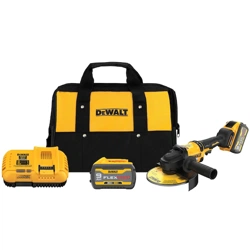Loading ...
Loading ...
Loading ...

13
ENGLISH
NOTE: The clamp nut
24
comes with the sanding
backing pad accessory sold separately.
4. Tighten the clamp nut by hand. Then depress the spindle
lock button while turning the sanding disc until the
sanding disc and clamp nut aresnug.
5. To remove the wheel, grasp and turn the backing
pad and sanding pad while depressing the spindle
lockbutton.
Mounting and Removing Hubbed
Wheels (Fig. J)
Hubbed wheels install directly on the spindle. Thread of
accessory must match 5/8"‑11 thread ofspindle.
1. Thread the wheel on the spindle
4
byhand against the
backing flange
7
.
2. Depress the spindle lock button
3
and use a wrench to
tighten the hub of thewheel.
3. Reverse the above procedure to remove thewheel.
NOTICE: Failure to properly seat the wheel before
turning the tool on may result in damage to the tool
or thewheel.
Mounting Wire Cup Brushes and
Wire Wheels (Fig. A, J)
WARNING: Failure to properly seat the brush/wheel
could result in serious injury (or damage to the tool
orwheel).
CAUTION: To reduce the risk of personal injury,
wear work gloves when handling wire brushes
and wheels. They can becomesharp.
CAUTION: To reduce the risk of damage to the
tool, wheel or brush must not touch guard when
mounted or while in use. Undetectable damage
could occur to the accessory, causing wires to fragment
from accessory wheel orcup.
Wire cup brushes or wire wheels install directly on
the threaded spindle without the use of locking
flange. Use only wire brushes or wheels provided with
a 5/8"‑11threadedhub.
1. Place the tool on a table, guardup.
2. Thread the wheel on the spindle
4
byhand against the
backing flange
7
.
3. Depress spindle lock button
3
and use a wrench on the
hub of the wire wheel or brush to tighten thewheel.
4. To remove the wheel, reverse the aboveprocedure.
NOTICE: To reduce the risk of damage to the tool,
properly seat the wheel hub before turning the toolon.
Prior to Operation
• Install the guard and appropriate disc or wheel. Do not
use excessively worn discs orwheels.
• Be sure the threaded locking flange are mounted
correctly. Follow the instructions given in the
AccessoriesChart.
• Make sure the disc or wheel rotates in the direction of the
arrows on the accessory and thetool.
• Do not use a damaged accessory. Before each use
inspect the accessory such as abrasive wheels for chips
WARNING: A closed, two‑sided cutting wheel guard
is required when using abrasive cutting wheels or
diamond coated cutting wheels.
WARNING: Use of a damaged flange or guard or
failure to use proper flange and guard can re sult in
injury due to wheel breakage and wheel contact. Refer
to the Accessories Chart for moreinformation.
Mounting non-hubbed wheels, without an
accessoryflange (Fig.G):
1. Place the tool on a table, guardup.
2. Place wheel
6
against the backing flange
7
,
centering the wheel on the raised center (pilot) of the
backingflange.
3. While depressing the spindle lock button and with the
hex depressions facing away from the wheel, thread the
threaded locking flange
8
on spindle so that the lugs
engage the two slots in thespindle.
4. While depressing the spindle lock button, tighten the
threaded locking flange
8
using a hexwrench.
5. To remove the wheel, depress the spindle lock button
and loosen the threaded lockingflange.
Mounting non-hubbed wheels, with an
accessoryflange (Fig.H):
1. Place the tool on a table, guardup.
2. Place the Type 27 spacer
22
against the backing
flange
7
.
3. Place wheel
6
against the Type 27 spacer
22
,
centering the wheel on the raised center (pilot) of the
backingflange
7
.
4. While depressing the spindle lock button, tighten the
threaded nut
23
using a hexwrench.
NOTE: The threaded nut
23
comes with the Type27
spacer accessory sold separately.
5. To remove the wheel, depress the spindle lock button
and loosen the threaded nut
23
.
Mounting Sanding Backing Pads (Fig. A, I)
NOTE: Use of a guard with sanding discs that use backing
pads, often called fiber resin discs, is not required. Since a
guard is not required for these accessories, the guard may or
may not fit correctly ifused.
WARNING: Failure to properly seat the clamp nut
and/or pad could result in serious injury (or damage to
the tool orwheel).
WARNING: Proper guard must be reinstalled for
grinding wheel, cutting wheel, sanding flap disc,
wire brush or wire wheel applications after sanding
applications arecomplete.
1. Place or appropriately thread backing pad
18
on
thespindle.
2. Place the sanding disc
17
on the backing pad
18
.
3. While depressing spindle lock button
3
, thread the
sanding clamp nut
24
on spindle, piloting the raised
hub on the clamp nut into the center of san ding disc and
backingpad.
Loading ...
Loading ...
Loading ...
